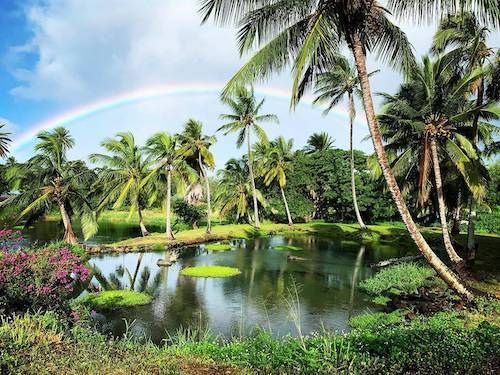Learning from Kilo
August 30, 2021
After teaching high school biology for 30+ years, Cindy Gay joined BSCS in 2016 as a Science Educator. She currently leads teacher professional learning and instructional materials work, and is the Principal Investigator for the project Connecting Our Youth to ‘Āina Through Investigations of Place. This is a story about her experience learning from kilo alongside the wonderful people in Hawaii.
All my life, my most influential mentors in art, science, and education have pressed me to look. Look carefully. Across scales and over time. Look again. More deeply. Look yet again. When I was introduced to the Loko ea fishpond ecosystem and one of her caretakers, Sayo Costantino, Kupuohi Education Program Director, I knew I had found mentors from whom I would learn much when they immediately invited me to look. And look again.
I arrived at the gates of Loko ea on the North Shore of O’ahu with my colleague Emily and six middle school science teachers from the moku (district) for the first day of our co-design conference. The conference marked the start of a NOAA-funded B-WET project to develop a 7th grade ecosystems unit exploring the intersection of traditional and scientific ways of knowing and incorporating both the NGSS and Nā Hopena A’o outcomes (Hawaiian cultural standards).
Sayo met us at the gates and we were invited to oli (chant) E HŌ Mai before entering Loko ea. This ancient Hawaiian oli is a powerful practice that creates deep resonance and vibration within the body, used as a way to clear space to call forth wisdom. As we entered Loko ea, I was struck not only by her beauty but by a sense of calm punctuated only by the sounds of bird calls and wind through the trees. I realized I had driven by her many times over the years—even eaten dinner in the restaurant in front of her gates—and never observed her presence. I was not looking.
After introductions, Sayo invited us to get to know Loko ea through kilo. Sayo shared that kilo refers to a Hawaiian approach of observing the environment and resources by listening to the subtleties of place to help guide decisions for management and pono (balance, prosperity) practices. Individually, we slowly moved around her fishponds observing living and nonliving, from lani (sky), ma uka (towards the mountains), and ma kai (towards the ocean) to small Samoan crabs feasting on algae at the edges of her ponds. Large kākū (barracuda) slipped silently past pua ‘ama (young mullet). As we came together and shared our kilos, our list was long and diverse, just like the Loko ea ecosystem.
Throughout the co-design of the unit, we continued our kilo by examining and reexamining the goals of the project to develop a common vision for the unit’s phenomenon and storyline. An important goal was to foster student understanding of ecosystem interactions through both traditional and scientific ways of knowing. During development of the unit, Sayo helped me look and look again at how traditional knowledge of fishponds was represented throughout the unit. Because my own understanding of ecosystems was first developed through scientific ways of knowing, I followed that pattern in writing student handouts, providing science ideas before traditional ideas about the role of abiotic factors in ecosystems. Sayo gently invited me to look again at the handouts to observe that presenting scientific ideas before traditional ideas was not only an inaccurate chronological portrayal, but it also implied traditional ways of knowing as secondary to scientific ways of knowing. Looking more deeply at my own implicit biases helped me elevate traditional ways of knowing throughout the unit.
Our partnership with Sayo and Loko ea produced a unit more robust than envisioned in the original proposal. Students begin the unit with their own kilo of Loko ea. At multiple photo stations, they document changes in Loko ea resulting from management practices designed to restore the ecosystem. Using the FieldScope platform students gather and analyze data from Loko ea’s waters to use as evidence in arguments for management strategies. They participate in stewardship activities to remove invasive California grass. Sayo has offered Loko ea as a host site for hoikas (public sharing of knowledge) for the unit’s culminating task: present an argument for a management strategy for Loko ea so we can sustainably feed people and the ecosystem is healthy and pono.
I am grateful to Sayo and Loko ea for helping me begin to learn Nā kilo ‘āina (traditional Hawaiian observation approaches). They represent the strengthening of community watchers and observers who understand the needs of community (people and place) and provide direction to ensure the ‘āina (land) is able to sustain us into the future. I am excited that our unit will help seventh grade students begin to learn about the importance of place through their own kilo.
About the Unit
The Restoring Ea Middle School Science Unit is a place-based, three-dimensional, and phenomenon-focused unit specifically designed for seventh grade teachers and students in central O’ahu. It is now freely available.
